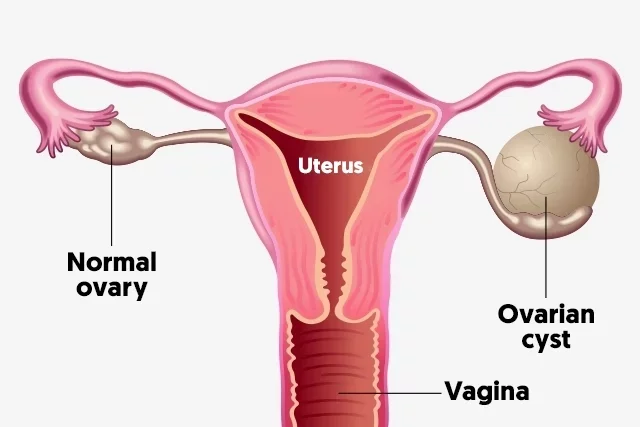Ovarian cysts are fluid-filled sacs or pockets that exist inside or on the surface of the ovary. On each side of the uterus, women have two ovaries, each roughly the size, and shape of an almond. During the reproductive years, eggs (ova) grow and mature in the ovaries and are released in monthly cycles.
Many women develop ovarian cysts at some point in their life. Most ovarian cysts cause no pain and are completely safe. Without therapy, the vast majority of cases fade after a few months.
However, ovarian cysts especially ruptured cysts, can cause severe symptoms. Get frequent pelvic exams and look out for signs that could indicate a potentially significant condition to safeguard your health.
OVARIAN CYSTS SYMPTOMS
Most cysts are asymptomatic and disappear on their own. A large ovarian cyst, on the other hand, could cause:
- Pelvic pain – dull or sharp pain in the lower abdomen on the side of the cyst.
- Abdominal fullness or heaviness.
- Swelling.
- Weight gain can be drastic in some cases due to hormonal imbalance.
When should you see a doctor? Seek medical help right away if you have:
- Severe abdominal or pelvic discomfort that occurs suddenly.
- Pain accompanied by fever or vomiting.
If you experience any of the following signs and symptoms of shock: cold, clammy skin, rapid breathing, and lightheadedness or weakness seek immediate medical attention.
CAUSES OF OVARIAN CYSTS
Most ovarian cysts form as a result of the monthly cycle (functional cysts). Other forms of cysts are rarer.
1. Functional Cyst;
Each month, your ovaries produce cyst-like structures known as follicles. When you ovulate, the follicles create the chemicals estrogen and progesterone and release an egg.
A functional cyst develops when a normal monthly follicle continues to grow. Functional cysts are classified into two types:
- Follicular cyst; An egg breaks from the follicle and travels down the fallopian tube towards the middle of the menstrual cycle. A follicular cyst develops when a follicle fails to burst or release its egg but instead continues to grow.
- Corpus luteum cyst; When a follicle releases an egg, it begins producing estrogen and progesterone in preparation for conception. The corpus luteum is the new name for this follicle. Fluid can build up inside the follicle, causing the corpus luteum to develop into a cyst.
Functional cysts are often painless and dissolve on their own after two or three menstrual cycles.
2. Other types of Cysts
Cysts that are not related to the regular functioning of the menstrual cycle include:
- Dermoid cysts; Also called teratomas are made up of embryonic cells, they may contain tissues such as hair, skin, or teeth. They are almost rarely malignant.
- Cystadenomas; These form on the surface of the ovary and can be filled with an aqueous or mucous substance.
- Endometriomas; These are caused by a disorder in which cells in the uterine endometrium grow outside the uterus (endometriosis). Some of the tissues can create a growth on the ovary.
Dermoid cysts and cystadenomas can become enormous, causing the ovary to move out of place. This increases your chances of experiencing painful ovarian torsion. The ovarian bust can occur by decreasing or interrupting blood flow to the ovary.
Read; Drugs and What to Consider in the Treatment of Ulcer
ELEMENTS OF RISKS
The following factors increase the chances of getting an ovarian cyst:
Hormonal problems; These include the fertility drug clomiphene (Clomid), which is used to induce ovulation.
Pregnancy; The cyst that develops during ovulation could sometimes remain on the ovary during pregnancy.
Endometriosis; The cells of the uterine endometrium expand outside the uterus due to this disorder. Some of the tissues can create growth in the ovary.
A severe pelvic infection Cysts could form if the infection progresses to the ovaries. Also having an ovarian cyst in the past is a chance are you will develop more in the future.
COMPLICATIONS
Some women have less common forms of cysts discovered by a doctor during a pelvic checkup. Cystic ovarian tumors after menopause can be cancerous (malignant). This is why it is essential to undergo frequent pelvic exams.
The following are uncommon problems related to ovarian cysts:
Torsion of the ovaries; Enlarged cysts can cause the ovary to move, increasing the likelihood of painful ovarian torsion (ovarian torsion). Rapid onset of severe pelvic discomfort, nausea, and vomiting are possible symptoms. Ovarian torsion can potentially reduce or eliminate the blood supply to the ovaries.
Rupture; A ruptured cyst can cause considerable pain and internal bleeding. The larger the cyst, the more likely it is to burst. Vigorous pelvic action, such as vaginal intercourse, also increases the risk of rupture.
Read More on Pain During Pregnancy…
PRECAUTIONS
When you notice the symptoms mentioned above persist for 3- 7 days after taking otc medications. You should consult with your doctor.
Self-medication can be very dangerous. When you barely understand your symptoms or notice drastic changes, especially after otc medications, consult your doctor immediately.



